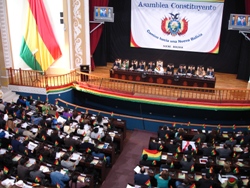Bolivian Constituent Assembly
The Constituent Assembly of Bolivia (Spanish Asamblea Constituyente ) was a democratic instrument of direct citizen participation in Bolivia. Their only goal was the development of the current constitution of the country. Legal basis was Article 2, 4 and 232 of the former Constitution and the law adopted on this basis Ley Especial de Convocatoria a la Asamblea Constituyente ( "Law for the convocation of the Constituent Assembly "). The Asamblea Constituyente adopted on 6 August 2006 for their work.
Historical Summary
After the return to democracy in Bolivia in 1982 there were the first attempts to revise the Constitution in 1990, when the indigenous people from the lowlands their march Por la dignidad, la tierra y el territorio ( " For dignity, soil and land") organized. The constitutional reform in 1994 finally recognized the multi-cultural and multi-ethnic character of the country, without the situation of Indigenous improve significantly. From 2000, the protests increasingly gained strength and influence. In 2002, the march was repeated, this time with the participation of indigenous peoples from the highlands and the call for a new constitution.
The then president Gonzalo Sanchez de Lozada tried to appease the protests in 2003 so that he promised to revise the Constitution through a Constituent Assembly. The proposal, however, his government no longer saved. He resigned in the fall and made room for the transitional government of Carlos Mesa. After the Constitutional Court was the possibility of a new Constituent Assembly to be incompatible with the former Constitution, Mesa created using the Ley Especial de Reforma Constitutional 2004 ( " special law on constitutional reform [ of ] 2004" ) this possibility through the redesign of Article 4 and 232 the Constitution.
The elected government in December 2005 under Evo Morales took advantage of the new constitutional article and adopted on 4 March 2006 unanimously in Congress, the Ley Especial de Convocatoria a la Asamblea Constituyente ( "Special Law for the convocation of the Constituent Assembly ").
Expiration
The choice of 255 MEPs ( Deputies ) was held on 2 July 2006, the Assembly adopted on 6 August ( the Bolivian National Day celebrating the independence from Spain in 1825) her work. The Deputies were paid during the time of the Asamblea as MPs and enjoyed parliamentary immunity.
210 deputies were elected to the 70 constituencies. The strongest in the constituency list each received 2 seats, the second strongest one seat 45 deputies were diagnosed in 9 departments. The strongest list received it two seats, the second largest one, the third - and fourth-strongest also a. As far as the third or fourth largest list did not reach 5 % of the vote, they were not fit, this was distributed according to the result of the other lists. Departamento La Paz 50 deputies, department of Santa Cruz 44, Departamento Cochabamba 35, Potosí Department 29, Department of Chuquisaca 23, Oruro Department 20, Department of Tarija 20, Beni Department 20 and Pando department: Due to the distribution of the constituencies, the following regional distribution of MPs revealed 14
As a result, the left-wing party, MAS received ( Movimiento al Socialismo ) of President Evo Morales with 154 deputies absolute majority, but they missed the 2/3-majority.
For the drafting of the Constitution by the Asamblea Constituyente six months were planned up to 1 year. The new constitution had to be adopted with 2/3-majority, so that the ruling MAS had to agree with other political parties and their ideas could not be implemented alone. After the Asamblea had agreed on a design, this had to be confirmed by the people in a constitutional referendum to take effect. Was necessary to the absolute majority of registered voters. Had this been missed, the old constitution had remained in force. The Because of domestic political tensions and violent confrontations after long delays that have been made draft constitution was adopted 25 January 2009 with a clear majority of the Bolivian people.
Autonomy referendum
The new constitution should contain a statute of autonomy for the departments. These were held simultaneously on 2 July 2006 with the election of deputies to the Asamblea Constituyente a referendum in which the individual departments determine whether they wanted to fall under this Statute of Autonomy. Was required was a simple majority of the votes cast. After a long dispute, the parties had agreed that the decision for the Asamblea Constituyente would be binding. Legal basis was the Ley de Convocatoria Nacional para las al referendum Autonomias Departemantales ( "Law on the convening of a national referendum on the autonomy of the Departments " ) under Article 4 of the old constitution. In the four located in the eastern lowland departments of Beni, Pando, Santa Cruz and Tarija (Media Luna ) the majority voted for autonomy, in the other five departments in the western highlands (Cochabamba, Chuquisaca, Oruro, La Paz and Potosí ), a majority against the autonomy and for the maintenance of a centralized State.








